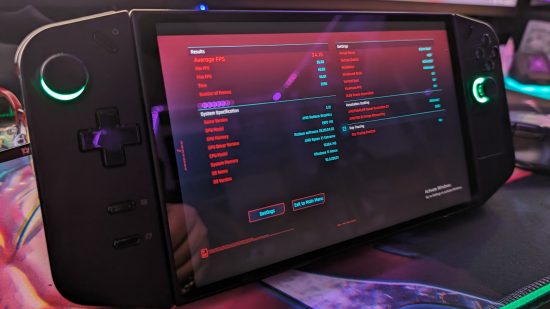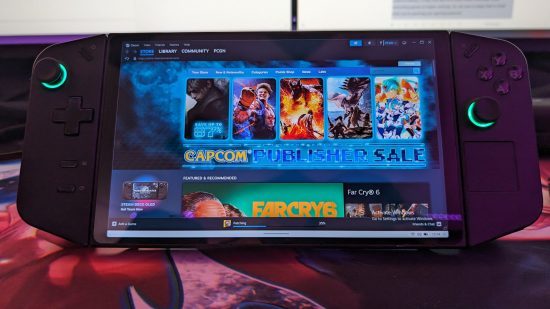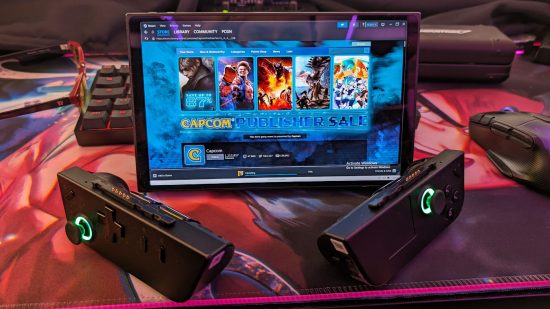Lenovo Legion Go review

Our Verdict
The Lenovo Legion Go isn’t just another gaming handheld in an increasingly crowded market; it’s a bold attempt at redefining what portable PC gaming can be. While it may not boast the raw power of some alternatives, and might be too clunky for some, its unique features and full Windows 11 capability make it a compelling choice for a specific subset of gamers.
- Innovative FPS mode with detachable controllers
- Premium build quality
- Bright and wide 8.8-inch IPS screen
- Full Windows 11 support
- Two USB-C ports
- Limited battery life with intensive use
- Complex navigation
- Heavy
- Awkward detachment mechanism for controllers
- No significant performance advantage over competitors
The Lenovo Legion Go has made waves in the portable PC gaming market, introducing an eye-catching blend of innovation and performance. Launched as a competitor in a market that’s increasingly crowded with handheld gaming devices, this offering from Lenovo aims to carve out its niche by combining the power of PC gaming with the convenience of portability. With features like detachable controllers, a high-resolution display, and full Windows 11 capability, the Legion Go promises a versatile gaming experience that bridges the gap between desktop power and handheld flexibility.
However, with such power comes the question of compromise. The Legion Go faces the challenges of managing battery life, optimizing software for a handheld format, and ensuring ergonomic comfort without sacrificing performance. As the handheld gaming market becomes more sophisticated, with devices like the Steam Deck setting high standards, the Legion Go’s ability to meet and exceed these expectations is critical. This review delves into the strengths and weaknesses of the Lenovo Legion Go, exploring how it stands up against its promises and competition and whether it’s worthy of a place on our list of the best portable gaming consoles.
Why you can trust our advice ✔ At Pocket Tactics, our experts spend days testing games, phones, tech, and services. We always share honest opinions to help you buy the best. Find out how we test.
Price and availability
The Lenovo Legion Go positions itself firmly within the premium sector of the gaming handheld market, reflecting its high-end aspirations in its pricing structure. The base model, equipped with a 512GB SSD, retails at $699, which aligns with the upper echelons of portable gaming devices. For those requiring additional internal storage, the 1TB version demands a slight premium, priced at $749. This pricing strategy places the Legion Go in direct competition with other flagship handhelds. It highlights its ambition to carve out a niche within this competitive landscape.
The unique selling points of the Lenovo Legion Go, notably its detachable controllers and innovative FPS mode, contribute to its premium positioning. These features offer a distinctive gameplay experience, potentially justifying the investment for enthusiasts seeking versatility and a novel approach to handheld gaming. However, the price point also necessitates a critical evaluation of the device’s overall value, especially when compared against competitors offering similar or superior hardware specifications. Prospective buyers must weigh the benefits of Legion Go’s unique features against its cost, considering the immediate financial outlay and the long-term value proposition.
Specs
The Lenovo Legion Go positions itself in the handheld gaming market with notable hardware specifications. The device powers performance by utilizing an AMD Ryzen Z1 Extreme processor. This choice aims to balance performance and power efficiency for mobile gaming. The 512GB and 1TB models have 16GB of LPDDR5 RAM. This specification suggests the device can handle multitasking and modern gaming demands without significant compromise.
One of the Legion Go’s most defining features is its 2560 x 1600 8.8-inch IPS display. This large, high-resolution screen is somewhat unusual for handheld gaming devices, potentially offering an enhanced visual experience for detailed game environments. The display’s capability to reach a refresh rate of up to 144Hz is also notable, suggesting smoother gameplay, which is particularly beneficial for fast-paced titles.
Here’s a more straightforward specification comparison for both models of the Lenovo Legion Go:
| Specs | 512GB model | 1TB model |
| Processor | AMD Ryzen Z1 Extreme | AMD Ryzen Z1 Extreme |
| RAM | 16GB LPDDR5 | 16GB LPDDR5 |
| Storage | 512GB SSD | 1TB SSD |
| Display | 8.8-inch IPS (2560 x 1600 pixels) | 8.8-inch IPS (2560 x 1600 pixels) |
| Refresh rate | Up to 144Hz | Up to 144Hz |
| Connectivity | Wi-Fi 6, Bluetooth 5.1 | Wi-Fi 6, Bluetooth 5.1 |
| Ports | USB-C, MicroSD, 3.5mm | USB-C, MicroSD, 3.5mm |
| Battery life | Estimated up to 8 hours | Estimated up to 8 hours |
| Operating system | Windows 11 | Windows 11 |
| Special features | Detachable controllers, FPS mode | Detachable controllers, FPS mode |
Features
The Lenovo Legion Go is an excellent gaming device with detachable controllers. These controllers charge wirelessly when connected to the central unit and let you play FPS games uniquely. One of the controllers can transform into a vertical mouse, offering PC gamers a more precise and familiar control scheme for first-person shooters. The Legion Go is perfect for gamers who want more than touch controls or standard thumbsticks, blending traditional PC gaming experiences with the flexibility of handheld gaming.
The Legion Go’s kickstand is also pretty awesome. Unlike competitors, it can support the device at various angles, making it perfect for tabletop gaming. You can adjust it to find your optimal viewing angle, making it a more comfortable gaming experience, especially during long gaming sessions.
The Legion Go runs on Windows 11, offering access to a vast library of games and applications. It’s not just for gaming – you can also use it for productivity apps! We prefer gaming, but you do you. With dual USB-C ports, you can charge it quickly and connect it to various accessories, including external displays and storage solutions, expanding its functionality.
When it comes to the Lenovo Legion Go’s proprietary software, it falls behind the competition. It’s slow, doesn’t pick up some games on the handheld, and is poorly optimized. There are ways around this and plenty of other digital storefronts, such as Steam and GoG, but you should still use Legion software just for software and security updates.
Design
The Lenovo Legion Go is a savage-looking gaming device. It’s visually super cool with its metallic-like finish on the back panel, and the build consists of high-quality materials that make it feel durable and sturdy. However, it’s one of the heavier and bulkier options in the gaming handheld market.
The Legion Go comes with an 8.8-inch screen and detachable controllers. This design choice provides a more significant display area and a comfortable grip for long gaming sessions. Nevertheless, it might be challenging for those with smaller hands or who value compactness in a handheld gaming device.
The device features two USB-C ports, one at the top and one at the bottom. These ports connect additional peripherals and charge the device quickly without affecting the user experience. Even though it has many advantages, the Legion Go is a niche offering within the handheld gaming sector. It fits those prioritizing a premium build and a larger screen over portability but still has drawbacks.
Display
The Lenovo Legion Go is a portable gaming device with an 8.8-inch IPS display that blows your mind with its impressive 2560×1600 resolution. It’s not just about the looks, though, because it also supports a refresh rate of up to 144Hz, which makes the action smoother and more enjoyable. This feature is handy for competitive gaming, ensuring the visuals sync with the gameplay.
But, the high-resolution and high-refresh-rate display can drain your battery faster and make your device slower. The processor and GPU have to work harder to support these features, which can result in shorter play sessions on a single charge. So, you need to balance visual quality and battery life by adjusting settings based on your preferences. A good tip for new users would be to turn auto rotate off, which is overly sensitive on Lenovo Legion Go.
The IPS panel ensures accurate color reproduction and a wide viewing angle, enhancing the gaming experience. This feature also makes the Legion Go an excellent option for watching movies and other content that require high-quality visual output. However, the screen’s glossiness and reflectiveness can pose visibility issues under direct sunlight, a common trade-off with displays prioritizing color depth and contrast.
Performance
The Lenovo Legion Go is an excellent handheld gaming device that runs on the AMD Ryzen Z1 Extreme processor and has 16GB of LPDDR5 RAM. It’s a versatile player that works great with games that don’t require a lot of graphics power, and it can handle more demanding games (although you might need to mess with the settings to get it just right).
The 144Hz display’s super-smooth gameplay has limits, especially with newer or more graphically intense games. You might have to choose between looking great and playing smoothly. This problem isn’t unique to the Legion Go, but it is still one to point out if you plan on running demanding games using the console.
The Legion Go’s cooling system is essential for running the device smoothly during long gaming sessions. It’s super efficient and keeps the performance consistent over time without overheating. But it can be loud when working hard to keep the system cool, so you might want to play using a Bluetooth headset if you don’t want to miss a line of dialogue.
Battery
The Lenovo Legion Go has a battery that supports its high-performance hardware and large, high-resolution display, which is pretty cool. But the battery life can be painful if you plan a long gaming session. It all depends on the types of games you’re playing and the settings you’ve chosen. You will burn through the battery quickly if you run demanding titles at maximum settings. You might have to keep it plugged in after just a few hours.
The good news is that the Legion Go offers versatile charging options, so you can charge it while playing. It has dual USB-C ports placed at the top and bottom, making it easy to charge it in a vertical stand mode. But, if you’re using the device heavily, you’ll need to charge it frequently, which is a pain.
The Legion Go’s battery capacity struggles to keep up with the device’s powerful components and the energy demands of modern gaming. It’s solid enough for short to moderate play sessions, but if you want to play for a long time, look for a less powerful handheld gaming console. It’s a trade-off between enhanced performance and superior display quality on one hand and battery endurance on the other.
Should You Buy The Lenovo Legion Go?
Are you thinking of buying the Lenovo Legion Go? Well, it all comes down to what you’re looking for. The Legion Go has some fantastic features, like detachable controllers that you can use as a vertical mouse in FPS mode and a big high-refresh-rate display. Plus, it runs on Windows 11, which gives you a lot of flexibility, and you can charge it up using the dual USB-C ports while connecting to other devices easily.
But there are some downsides, too. It’s bulky and heavy, so it might not be as portable as other handheld gaming devices. And while it has impressive hardware, you may have to sacrifice some performance to play graphically intensive games at its native resolution. Plus, using Windows on a handheld device can be tricky.
Another thing to consider is battery life. Even though the Legion Go has a powerful battery, it may only last for a short time if you play more demanding games at higher settings. So, be sure to keep that in mind when you’re planning your gaming sessions.
Ultimately, the Lenovo Legion Go is a niche product ideal for gamers who want a portable device with versatility and screen quality. You should look into other options if you prioritize portability and ease of use over sheer power and screen size. When deciding, consider the pros and cons carefully and how the Legion Go’s specific advantages and disadvantages align with your gaming preferences and needs.
Alternatives
If our Lenovo Legion Go review hasn’t sold you, check out our suggestions for alternatives below.
Steam Deck OLED
The Steam Deck OLED is the obvious alternative to the Lenovo Legion Go. It’s more streamlined in terms of software while requiring less setup and has a massive library of available games, many of which are often on sale. Until the arrival of the Steam Deck 2, we’re confident saying that the Valve handheld is still the best portable gaming PC out there. For more details on this one, check out our Steam Deck OLED review.
Nintendo Switch OLED
Okay, hear us out on this one. A portable PC is all well and good, but if the Lenovo Legion Go sounds a little complicated, you still can’t go wrong with the Nintendo Switch OLED. What it lacks in performance power, it makes up for with easy-to-use UI and a massive library of games. Sure, we’re expecting the Nintendo Switch 2 imminently, but for now, Nintendo’s superstar console is still worth checking out for great gaming on the go. If you want to know more, see our Nintendo Switch OLED review.







